California Gold Quartz Specimen Natural Gold Nugget 10.7 Gram Gold In Quartz
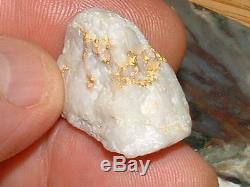
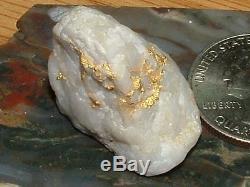
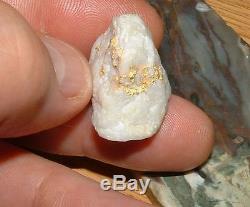
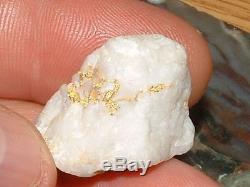
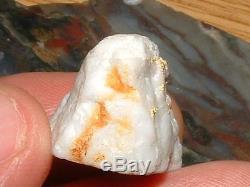
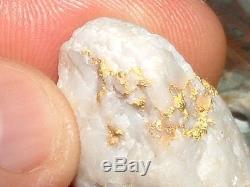


NATIVE GOLD QUARTZ SPECIMEN from the MOTHER LODE. R uler is 1/4 wide (6 mm). 10 cent coin is 17 mm in diameter.
S pecimen weight: 10.7 G ram - 166 G rains. S ize: 25.4X18.8X18.5 mm. I f you've an eye for gold straight from the earth, check out this sizable rock from the Sierra Nevada Mtns. It weighs 166 grains (Troy).
On one side, orange-staining coats part of the quartz. It's a neat piece of California Gold Rush history. The gold is of high karatage while the gem-grade stone (host rock) appears to be very dense. It will make a great addition to your collection of native gold specimens. B ack when I actively mined, gold nuggets would sometimes show up with host rock attached. Usually this was quartz although sometimes a softer carbonate or rhyolitic rock filling might host the gold.Considering the primary contact zones found in the region, this made perfect sense because the veins themselves originated along and within the walls of these contacts. During my prospecting years, there were times when gold-bearing veins were located in this manner; however, because of the enormous cost and difficulty in developing lode deposits, I preferred leaving lodes to the hard-rock miners.
The thing about discontinuous fissure veins is that ore tenor is rarely consistent in it's richness or placement. Assays, a task which generally is commissioned, are rather expensive as well. Also, single assays aren't really going to indicate how extensive an ore body is. More astute hard-rockers, knowing this, would probably opt to assay samples themselves since that will become an ongoing process during the development of a hard rock mine.In pocket country, whenever a potential source of eroding placer gold is found in the form of an attractive vein system, it's advisable to take samples and detect the heck out of the area. You might get lucky and discover a pocket or quartz lens which is still shedding gold. Generally-speaking, placer was my focus, and no matter how disfigured, discolored, deformed, or impure a nugget might be, I never found a piece of gold I didn't like.
It takes a lot of effort to find gold whether it's placer, a pocket, or a deep, hard-rock lead, so there's really no such thing as an'ugly nugget' or specimen. Each one is beautiful in it's own way.I guarantee the gold growths here are a natural occurrence. All my specimens show visible gold and are authentic gold quartz specimens. I don't paste'pounded gold' or spray gold-colored paint on barren rock.
Refractory ores, which need to be heated and run through special processes to release the minute amount of gold locked up inside, aren't usually my thing. When I do sell sulphides, you'll be able to see gold associated with the pyrites. You won't need to crush and treat my rocks with cyanide solution to extract the gold. Nor are we dealing in micron gold.
I deal in genuine high-grade, naturally-occurring gold quartz with visible gold, both as specimen and as jewelry-grade slab. Such rich rocks and lapidary rough are hard to find and expensive to obtain. I poured through old mining dumps for years looking at orange-yellow-rusty rock through a loupe, but I never found a piece with visible gold. Hydrothermal solutions carrying gold and silica crystallized into veins of gold quartz. This specimen comes from one of the many vein systems sourcing the immense placer deposits of the Sierra Nevada Mtns, the famed Mother Lode. 15.43 GRAINS = 1 GRAM. 31.103 GRAMS = 1 TROY OUNCE.24 GRAINS = 1 PENNYWEIGHT (DWT). 20 DWT = 1 TROY OUNCE.
480 GRAINS = 1 TROY OUNCE. We leave no stones unturned insuring our customers get what they bargained for. If you're not satisfied with this item, contact me.PLACER GOLD DEPOSITS & REDEPOSITS. L et me share some observations based upon my 18 years of experience exploring both wet and dry placer-fields. I n the lower 48, if the main drainage exiting a gold source area held decent-paying ground originally, chances are good the old time miners plundered it, but there's still glimmers of hope. Few old placer diggings have been completely worked out. Alluvial fields which are both deep and expansive may cover many miles of linear distance.
Conversely, the placer discovery area may be confined to a single wash or creek. Suffice it to say that shallower gravels were, and continue to be, far easier to prospect and mine than deep gravel deposits. These represented the easiest claims for the old timers to milk.
Still, of the many relatively shallow gravel claims I've prospected with pick-axe and shovel, it was rare not to be able to scare up a little gold some place. During intervening years, intermittent high waters continue to erode creek and riverbanks while also cutting through old tailings, abandoned diggings, and, quite possibly, virgin clip zones; so, to a limited extent, lost gold might still be replenishing these drainages. Finding traces here and there isn't going to cut it for'big operators', but it might be enough to satisfy'the itch' for many small scale and recreational miners. Regarding virgin placer deposits, the depth of ancient channels, the density of the alluvial pack, and the concentration of boulders often makes thorough testing impossible (by hand methods). The same can hold true for operators of heavy equipment if there are massive boulders, cemented gravels, or permafrost conditions In the case of deep gravel deposits, with so much sedimentary rock layered on top of older strata, boo-coo un-worked, untested bedrock material might remain on these properties, but there remains the need for large mechanized excavators to reach potential pay-streaks and pay-layers (alluvial strata).In gold country, one can never know what values lie 5 feet inside an 80 foot deep stretch of remnant river channel the'giants' of yesteryear failed to blast away. Finding payable redeposits or a virgin pay-pack, takes thorough testing and the onis is on you to make that determination. Wherever the goldfield you are prospecting, sediments need to be sampled for gold across their entire width whether it's a creek, river, dry-wash, alluvial fan, or pediment. In some cases, it may even be advisable to sample the overburden. This is especially true in the case of desert placers.
If you're familiar with mountainous terrain, you know what a tall order this is, an impossible task in many cases. The linear and vertical scale encountered in expansive canyon-lands makes for tough sampling due to the sheer volume of gravels in potential deposits. Only operators loaded for bear with gigantic excavators, cats, front-end loaders, and such can open up and test such ground effectively. The general rule is that any pay-dirt found in channels, whether they are recently deposited sediments, or of even greater antiquity (Quaternary to Tertiary age and older), will be concentrated on, in, just above bedrock, or any combination of those three pay zones. In many instances, good-paying flood gold deposits might be encountered in the uppermost strata of the most recently-deposited stream/river gravels. Anything goes in desert and pediment-type deposits. In drier climes and areas where shallow-seated lode deposits continue to shed gold, the object of your desires might be discovered very close to the surface.These represent ideal targets for MDers hunting the many dry regions of the world. Sampling and not finding anything can become disheartening, but stopping too soon during the test phase of your operation means that if a pay-streak is hidden somewhere on your claim(s), you might overlook it (them) altogether. Now, with much higher gold prices, there are potentially valuable gold deposits in many sedimentary formations which might not formerly have been profitable to mine. Ancient auriferous channel remnants can be virtually anywhere and often have been found miles from younger, flowing waterways. Don't forget, if you save ten thousand dollars by'not' purchasing a lousy claim, you've thousands to invest in a promising claim someplace else.
Do you understand now how important a comprehensive testing program is? Thanks for checking out our digs. G old of E ldorado 1-14-13. The item "CALIFORNIA GOLD QUARTZ SPECIMEN NATURAL GOLD NUGGET 10.7 GRAM GOLD IN QUARTZ" is in sale since Wednesday, August 02, 2017. This item is in the category "Collectibles\Rocks, Fossils & Minerals\Crystals & Mineral Specimens\Precious Metals".
The seller is "egm947" and is located in Banks, Oregon. This item can be shipped worldwide.

